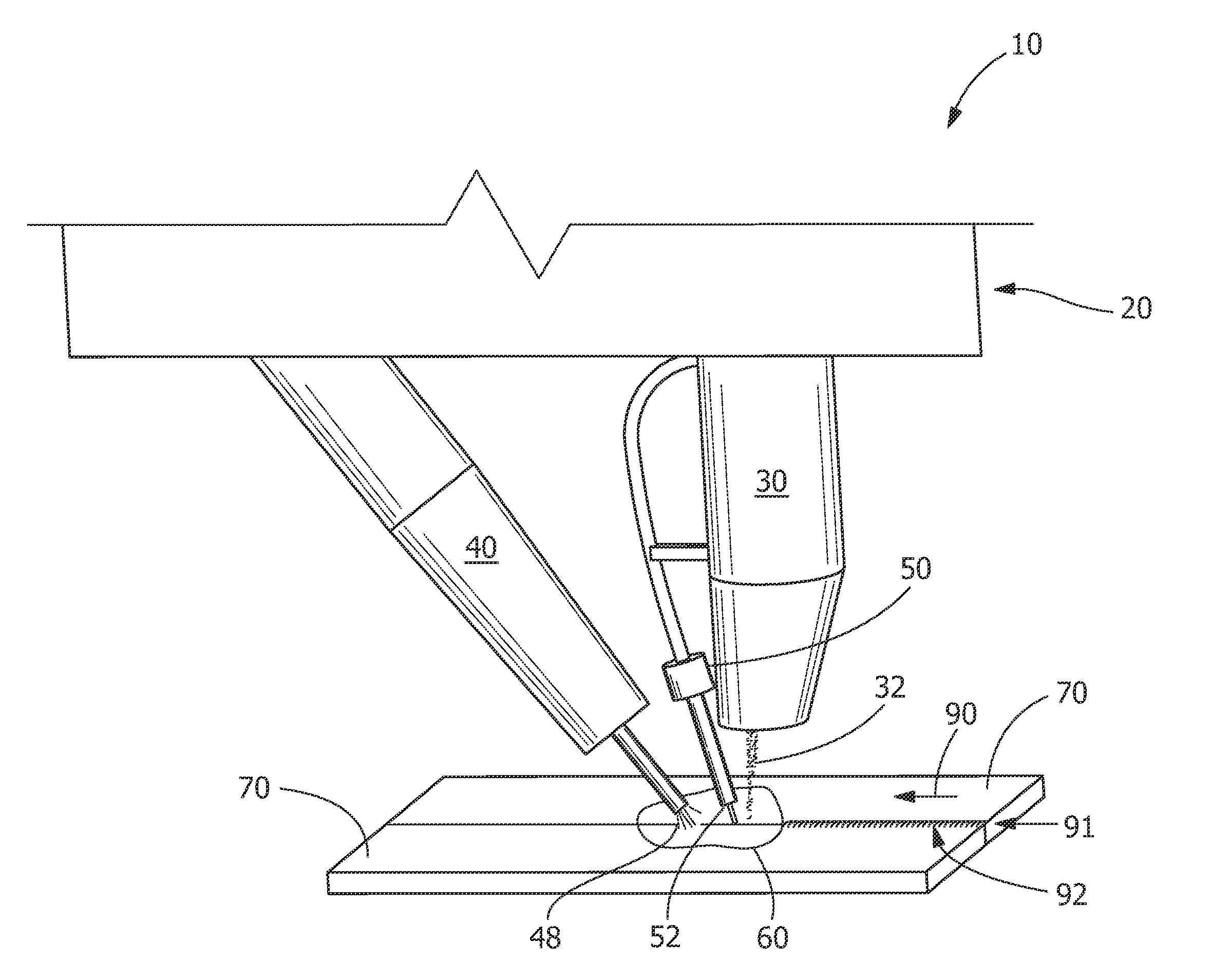Hybrid welding system and method of welding
- Summary
- Abstract
- Description
- Claims
- Application Information
AI Technical Summary
Benefits of technology
Problems solved by technology
Method used
Image
Examples
reference example 1
[0032]As shown in FIGS. 4 and 5, the first reference example includes joining two adjacent components 70 using a welding device. Welding device includes laser 30 having beam 32 and a consumable electrode electric arc welder 43. In this reference example, the consumable electric arc welder 43 is a GMAW torch with a consumable electrode 45 and a consumable electrode feeding device 47 for feeding consumable electrode 45. The welded components 70 were ⅛″ thick stainless steel (SS304, with a chemical composition of about 8-11% Ni, about 17.5-20% Cr, about 2% Mn, with balance Fe, available from Grainger Industrial Supply, Greer, S.C.) with a shear edge. The welding speed was 80 set to inches per minute (ipm). Laser 30 power was set at 4.0 kW and GMAW torch 43 setting was 230 ipm with a filler metal stainless steel (55308L, with a chemical composition of about 9-11% Ni, about 19.5-22% Cr, about 1.0-2.5% Mn with balance FE) and wire having a 0.889 millimeter (0.035 inch) diameter. As shown ...
reference example 2
[0033]As shown in FIGS. 7 and 8, second reference example includes joining two adjacent components 70 using a welding device. Welding device includes laser 30 having beam 32, non-consumable electrode electric arc welder 40, and wire feeding device 50. Wire feeding device 50 is in front of laser 30. Non-consumable electrode electric arc welder 40 is a GTAW torch 41. Wire feeding device 50 feeds wire 52 in front of laser 30 and GTAW torch 41. As shown in FIG. 7, wire feeding device 50 leads laser 30 in weld direction 90. In this reference example, welded components 70 were ⅛″ thick stainless steel (SS304) with a shear edge. The welding speed was set to 80 ipm. Laser 30 power was set at 4 kW (maximum setting) and the GTAW torch 41 setting was 218 A / 18V (maximum setting). The wire feeding speed of wire feeding device 50 was 230 ipm with a filler metal 308L wire 50 having diameter of about 0.889 millimeters (0.035 inches). The incomplete weld obtained from this example is shown in FIG. 8...
example 3
Present Disclosure
[0034]As shown in FIGS. 9 and 10, an example of the present disclosure is provided. The present disclosure joins two adjacent components 70 using hybrid welding apparatus 20. In the present disclosure, the welded components 70 were ⅛″ thick stainless steel (SS304) with a shear edge. Hybrid welding apparatus 20 includes laser 30 and non-consumable electrode electric arc welder 40, and wire feeding device 50 between laser 30 and electric arc welder with non-consumable electrode 40. In this embodiment, non-consumable electric arc welder 40 is a GTAW torch 41. Laser 30 power was set to 3.6 kW and GTAW torch, is set at 200 A / 18V. As shown in FIG. 9, laser 30 leads in welding direction 90. The welding speed was 80 ipm. Wire 50 feeding speed was 230 ipm with a filler metal 55308L having a 0.889 millimeter (0.035 inch) diameter and directed to shared molten pool 80 forming common molten pool 60 (see FIG. 2). As shown in FIG. 10, full penetration weld 92 including top weld ...
PUM
| Property | Measurement | Unit |
|---|---|---|
| Diameter | aaaaa | aaaaa |
| Diameter | aaaaa | aaaaa |
| Speed | aaaaa | aaaaa |
Abstract
Description
Claims
Application Information
 Login to View More
Login to View More - R&D Engineer
- R&D Manager
- IP Professional
- Industry Leading Data Capabilities
- Powerful AI technology
- Patent DNA Extraction
Browse by: Latest US Patents, China's latest patents, Technical Efficacy Thesaurus, Application Domain, Technology Topic, Popular Technical Reports.
© 2024 PatSnap. All rights reserved.Legal|Privacy policy|Modern Slavery Act Transparency Statement|Sitemap|About US| Contact US: help@patsnap.com










